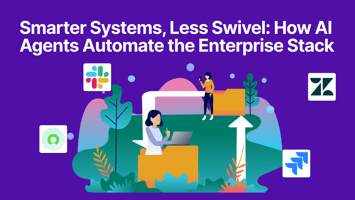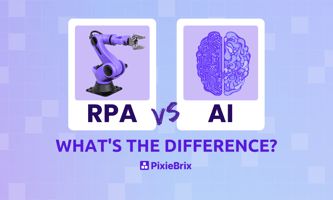From Chatbots to Agents: The Enterprise Shift Has Begun The hype around AI in the workplace often...
Why Enterprises Need Agentic AI Platforms: From Workflows to Autonomy

Beyond Copilots - The Rise of Agentic AI
While AI copilots have gained traction in enterprise support and sales, a new category is emerging: agentic AI platforms. These tools don’t just assist humans—they act. They observe, reason, decide, and execute across systems.
If copilots are GPS for your employees, agentic platforms are self-driving cars—handling not just suggestions, but full workflows.
In this article, we’ll break down what agentic AI is, how it works, and why it’s becoming essential for enterprise teams trying to scale smarter.
What Is Agentic AI?
Agentic AI refers to systems that can perform multi-step tasks autonomously, with minimal human input. Unlike traditional RPA or rule-based systems, agentic platforms can:
-
Interpret unstructured context
-
Make decisions based on goals and rules
-
Take sequential actions across tools (e.g., Salesforce → Jira → Slack)
-
Adapt when conditions change mid-process
They work like digital employees—capable of handling processes end-to-end.
Agentic AI vs. Chatbots vs. Copilots
| Feature | Chatbot | Copilot | Agentic AI |
|---|---|---|---|
| Interface | Conversational | Side-by-side assist | Behind-the-scenes executor |
| Dependency | Human-led | Human-led | Goal-directed autonomy |
| Context Awareness | Low | Medium | High |
| Examples | Tidio, Drift | Intercom Fin, Glean | PixieBrix, CrewAI, Adept |
Agentic AI moves beyond suggestions or responses - it takes initiative.
Why Enterprises Are Embracing Agentic AI
Reduce Repetitive Workflows
Agentic platforms can handle ticket routing, user provisioning, report generation, or data entry across tools. This eliminates the “swivel-chair” problem.
Close the Execution Gap
Instead of waiting for employees to act on suggestions, agents complete the workflow instantly. They reduce latency between intent and execution.
Standardize Complex Processes
Agentic AI codifies best practices across your org - applying consistent logic for approvals, triage, compliance checks, and more.
Improve Observability
Unlike shadow automations, agentic systems offer full visibility, audit trails, and explainability across workflows.
Enterprise Use Cases for Agentic AI
-
Customer Support: Automatically triage, route, and resolve support tickets across Zendesk, Slack, and Confluence.
-
IT Operations: Auto-provision access, escalate issues, and log actions across ServiceNow, Jira, and email.
-
Finance & Compliance: Detect anomalies, file incident reports, or trigger approval chains for flagged transactions.
Key Capabilities to Look For
When evaluating platforms like PixieBrix, Adept, or CrewAI, look for:
-
Multi-app workflow orchestration
-
Real-time screen/context awareness
-
Goal-directed agents with memory
-
No-code and dev-friendly interfaces
-
Security and auditability
Agentic AI in Action: From Prompt to Workflow
Example: A support agent flags a bug in Slack. An AI agent creates a Jira ticket, notifies engineering, updates the customer ticket in Zendesk, and logs the incident in Confluence - all without human follow-up.
How is agentic AI different from RPA?
RPA relies on static scripts. Agentic AI makes dynamic decisions and adapts to live context, often with no-code logic.
Does agentic AI replace employees?
No, it augments them. It frees teams from repetitive work so they can focus on strategic tasks.
What tools support agentic AI today?
PixieBrix, CrewAI, and Adept are early leaders in agentic AI for enterprise use cases.
Is agentic AI secure enough for enterprise use?
Yes, modern platforms support SOC 2 compliance, role-based access, and detailed logging.
Can business users build agentic workflows?
Many platforms offer no-code builders, decision trees, and workflow templates to enable non-developers.


